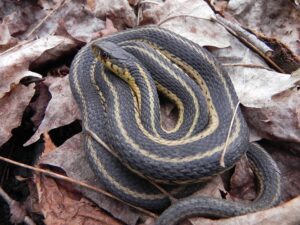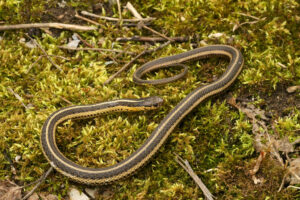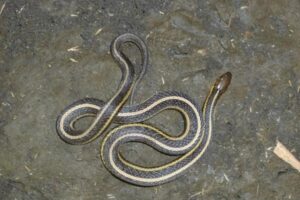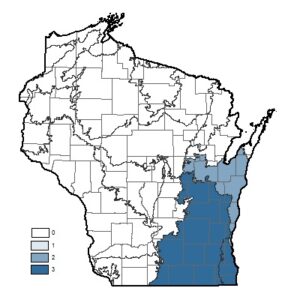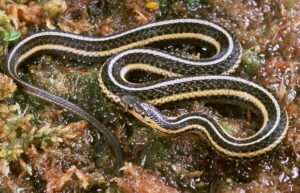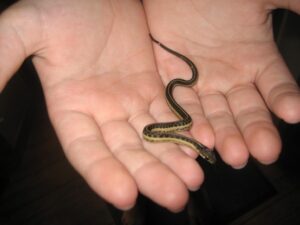Butler’s garter snake is a small, slender garter snake species endemic to North America. The specific name butleri is in honor of Amos Butler (1860-1937), an ornithologist from Brookville, Indiana. They are mostly active from early March through mid-November.
Scientific Classifications
- Suborder:Serpentes
- Family:Colubridae
- Genus:Thamnophis
- Species:T. butleri
Conservation Status
Description
Size
The adults have a total size of around 15-20 in (38-51 cm), including the tail.
Color and Appearance
There are 3 yellow stripes that run along the length of the body. 2 rows of black spots may be visible between the side and back stripes. The ground color ranges from olive-brown to black. The lateral stripes are centered on the 3rd scale row going up from the ventral scales. They also overlap the 2nd and 4th rows of scales. This placement of the lateral stripes distinguishes this species from other garter snakes. For example, the common garter snake’s (Thamnophis sirtalis) lateral stripes may include the upper half of the 1st scale row and always includes scale rows 2 and 3. Plus, the head is too small for a garter snake, and when excited, the effort taken by the serpent to escape is more concentrated on thrashing at a place rather than actually getting away. The scales are keeled and the anal plate is undivided.
Are They Dangerous to Humans
When threatened, the docile and shy snake prefers to flee than bite. If harassed, it releases a foul-smelling substance. Sudden surprise leads it to its body from side to side, apparently to startle and confuse the attacker. It never bites unless handled roughly.
Butler’s Garter Snakes at a Glance
Distribution
This garter snake is found in northeastern Indiana, northwestern Ohio, the eastern part of the Lower Peninsula of Michigan, and the neighboring extreme southern tip of Ontario, Canada. A disjunct population exists in southeastern Wisconsin.
Habitat
The Butler’s garter snake lives in grassy, moist, open canopy areas like wet prairies, meadows, savannas, marshes, and grasslands. It can be found in grassy vacant lots in residential and suburban areas. The diurnal serpent can be often found under logs, rocks, boards and trash.
The snake undergoes communal hibernation, often with other garter snake species.
Lifespan
The Butler’s garter snake lives for 6-14 years.
Predators
It has a variety of predators in its range, including milk snakes, hawks, American crows, owls, skunks, raccoons, weasels, foxes, shrews, and domestic cats.
Diet
Its main diet consists of earthworms. But it also eats salamanders, leeches, and frogs.
Reproduction
Ovoviviparous (gives birth to live young from eggs that hatch inside the body)
Mating occurs in late March and early April. The babies are born in June or July in broods of 4-14. The neonates are 5.1-7.1 in (13-18 cm) in total length. The short-lived species attains sexual maturity in its second spring.
Source
biolib.cz, flickr.com, eekwi.org, dnr.wi.gov, animaldiversity.org, dewittschools.net

